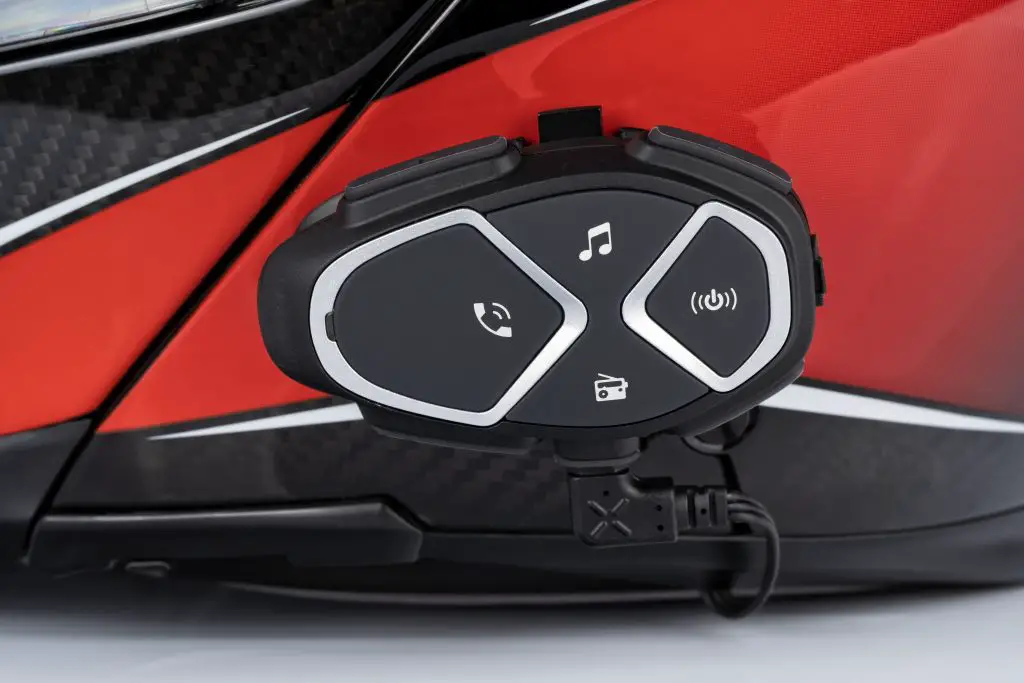It’s obvious, isn’t it, when you ask, “what are helmet speakers”?
They are ‘speakers in a helmet.’
At the overview level, this is true.
But there’s a little more to it than that.

You use headphones, headsets, or earbuds to listen to voice and music audio up close and personal. But what if you need to wear a helmet? How comfortable is that to do?
In many cases, if you want to fit your helmet over regular headphones, it’s not possible. And to squeeze them over earbuds is not easy or comfortable.
So along came helmet speakers as an aftermarket add-on in the 1970s.
Improvements were made to existing headphones or earbud devices to incorporate a small speaker to fit inside the helmet.
The design and capability of these devices have changed dramatically. As a result, the market has grown in volume into multi-millions of dollars. As you will see, it has gone from being a luxury item to a must-have accessory that is not just for riding motorcycles.
But before we do, let’s consider why helmet speakers have become so popular in a little more detail.
Why helmet speakers?
Helmet speakers avoid the discomfort and potentially ear damaging effects of wearing headphones and earbuds inside a helmet.
The Problem with Headphones and Helmets
Helmets are designed to be close-fitting, fit snugly around your head, and stay on in the event of a collision.
Headphones also need to stay on your head as you move around, so they have a curved metal or plastic band (with the speakers attached and adjustable at each end to fit over your ears) that sits on your head.
There is no way you can pull on a tightly fitting helmet designed to fit the shape of your head over headphones.
Are Earbuds Any Better with Helmets?
You would think that earbuds would be an easier fit, and in some cases, they are.
But they still protrude out from the ear, even if only a little, and often will rip out of the ear as you pull on your helmet. And what you try to put the earbuds back in with the helmet on? Well, that’s nigh impossible.
More than this, though, earbuds sit much closer to those delicate eardrums of yours. Turning the volume up because of the road or outside noise to hear your music or listen to your phone caller could cause permanent hearing loss over time.
And there are also other problems with earbuds:
- Pressed into the ear canal by the helmet for a few hours, riding could lead to ear pain or discomfort at the very least and may lead to overheating.
- Wired earbuds mean wires that hang out of the helmet connecting to your smartphone. There’s the risk of getting tangled up with them while riding. And maybe even attracting the attention of the traffic police – not what you want.
Why Helmet Speakers?
- Helmet speakers are explicitly designed to fit into a helmet, avoiding blocking the ear canal as earbuds do. This design means you have a comfortable fitting helmet and no overheating in the ear.
- Helmet speakers are engineered to provide an optimum acoustic sound that does not block out environmental sound, which is vital from a safety perspective if not from a legal viewpoint.
- Many helmet speakers have wiring tucked under the helmet’s lining, so there is no loose wiring that can be a safety hazard.
Now that you know the why for helmet speakers, it’s important to understand there are three different types of helmet speakers available in the marketplace, one of which is outside the scope of this article.
Types of Helmet Speakers
Up until now, I’ve been talking about helmet speakers as an add-on product. They come in two types: wired and wireless.
As the word add-on implies, these speakers are bought separately from the helmet and then fitted into the helmet.
The kit will include a headset, speakers, microphones, charging cable, clips, and sticky pads depending on the make and model. I’ll talk later about the variations in the kit and how the components all fit together.
The third type of helmet speaker is built into the helmet itself.
Let’s consider each type in turn.
1. Wired Helmet Speakers
Fitting a wired helmet speaker is essentially the same as a wireless helmet speaker.
The difference becomes with the connection to the sound device, whether an Android smartphone, iPhone, music player, iPod, etc.
To listen to audio on your wired helmet speaker, you need to physically connect a cable between the speaker and the sound device. This is typically by way of a 3.5 mm connector plug and a long cord.
If your sound device has Bluetooth, you can use Bluetooth, but it usually means you have to buy a Bluetooth adapter separately.
I’ve already outlined the problems that come with wired devices fitted to helmets, so it’s much preferable to use the second type of speakers, i.e., those that come with a wireless connection.
2. Wireless Helmet Speakers
Again, the difference is with the connection to your audio device with the wireless version.
Here the connection is without wires and is achieved by way of Bluetooth. It means that the sound device like a mobile phone or speaker needs to be Bluetooth-enabled which is not a problem these days as most devices come with that capability.
The added advantage of the wireless speakers is that if included in the design, you can communicate with your pillion passenger or even other riders in your group, provided they are within range.
But as with the wired helmet speakers, you have to spend some time installing the speakers in the helmet after purchase. Wouldn’t it be better to avoid the hassle and have the speakers already built-in?
3. Built-In Helmet Speakers
And these days, you can buy ready-made built-in helmet speakers because many helmet manufacturers are embedding speakers in their helmets with all the features you find with the two add-on products.
Buying these types of helmets avoids all the hassle.
Make the purchase, pair it with your sound device, and you’re good to go.
But for this post, I won’t be going into any further details on these types of helmets or the different Helmet brands. That’ll be the subject of another post.
So now I’ll move on to explaining more about what makes up a helmet speaker, how they operate, and the different capabilities you get to enjoy, whether that’s with a wired headset or a Bluetooth headset.
How Does a Helmet Speaker Work?
Most helmet speakers are Bluetooth-enabled, so I’ll talk about how these types work.
And to understand how they work, it makes sense to know what their components are.
What’s In the Box?
The supplier may describe them differently, but here are the main components you’ll typically find in the box.
1. Bluetooth Headset
This is the primary unit that is either clipped to the side of the helmet (helmet clamp provided) or attached to the side of the helmet by sticky pads (provided). Often helmets are too thick for the clips, so sticky pads have to be used.
2. Speakers
The speakers fit inside the helmet adjacent to each ear. Wiring tucks under the helmet lining. It comes out on the underside of the helmet and plugs into the main unit.
3. Microphones
Sometimes, you’ll find a boom microphone (hard), a soft microphone, or both supplied. They are attached to the same wiring as the pair of helmet speakers and are usually interchangeable.
The hard microphone extends from inside to outside the front of the helmet (hence the boom description).
The soft microphone sits in the front inside of the helmet.
4. USB Cable
This is used for connecting to a smartphone or other sound device and charging the speakers and may be either a micro or a Type C type cable.
5. Batteries
Sometimes external batteries are required and are usually included in the box.
How Do Helmet Speakers Operate?
Once fitted, Bluetooth helmet speakers require pairing with the smartphone or sound device you’ll take with you. From then on, the speakers will operate in the same way as any other paired device.
Except that when you’re on the move, it’s decidedly dangerous and unsafe to look at the controls on your audio device. So don’t do that.

Depending on the make and model, control is provided in one or both of two ways. At the very least, the Bluetooth main unit will have a dialing knob that directs how the device is used. Additionally, there may be the option to issue voice commands.
So if helmet speakers are mostly Bluetooth-enabled, do they offer most functions available with Bluetooth? The answer is a resounding yes. Read on to confirm what those functions are.
What Functions Do Bluetooth Helmet Speakers Offer?
The extent of the functions provided by your Bluetooth helmet headset will depend on the version of Bluetooth installed. Many will have at least Version 3 or a variant of Version 4, in which case most of the capabilities you expect with Bluetooth will be available. It will also depend on the version of Bluetooth installed on your audio device.
Rather than changing operations on the audio device itself, Bluetooth commands can be wirelessly sent by turning or and/pressing a dial button on the main unit. So there’s no restriction on what commands you can use. You don’t have the hassle of having to stop or, even worse, making changes while you’re in motion.
This means you can do the following handsfree:
- Making phone calls on your mobile phone
- Accept calls on your mobile phone
- Listen to music and change tracks when you want to
- Hear voice instructions from your GPS navigation app
- Have intercom conversations with your passenger or other people within your group of riders, skiers, etc.
- Share music with your passenger
- Seek and listen to an FM station
In many makes and models, you can make these same actions by issuing voice commands wirelessly, which is safer because it avoids taking your hands off the handlebars or affecting your ski stick action.
Mentioning handlebars and skis at this point prompts the question of who uses helmet speakers?
Users of Helmet Speakers
Initially developed for use in cars, helmet speakers have spread far and wide.

Now they are used by:
- Motorcyclists
- Skiers
- Snowboarders
- Snowmobilers
- Cyclists
Depending on which model they buy, each type of user has the option to use their helmet speakers in solo or group mode.
Group mode can range from pairing with your passenger or up to 16 people in your group. And that can be motorcyclists or cyclists out riding the open road, skiers, and snowboarders on the slopes, or those out on their snowmobiles exploring the forest.
So there is an immense upside to the use of helmet speakers. But are there any disadvantages?
Let’s find out.
Disadvantages of Using Helmet Speakers
There are downsides to using helmet speakers, one of which revolve around the very reason for their existence. That’s because they fit into helmets. And you wear helmets to protect your head from accidents while you are in motion.
Let’s examine what that means practically.
Phone Calls
Just like when you’re in a car, making and answering calls is not safe.
If you can’t issue voice commands, you have to take your hands off the handlebars to accept and close the call.
But even aside from this, the National Safety Council claims that driver distraction with particular reference to cell phone usage while on calls is now a leading factor in fatal and serious road injury crashes alongside alcohol and speeding. So, probably not the best to answer or make calls while riding or in motion.
Intercom Conversation
Intercom usage with members of your group means you usually all need to buy the same model of helmet speaker or at least the same brand. It’s understandably an approach manufacturers take to keep buyers within their ecosystem, just like Apple. However, it might mean you have to compromise your requirements to talk with your group while riding or skiing.
Some helmet speakers are available, though, that have universal pairing capability. The universal capability allows you to communicate with other Bluetooth communication devices no matter the manufacturer. But, unfortunately, it may mean you have to pay a premium for that convenience.
You also need to understand that the intercom range is not infinite, so the group needs to be kept reasonably close to ensure communication doesn’t drop out. However, some manufacturers now have helmet speakers with a range of over 2 miles which is impressive.
Sound Quality
The design and sound technology built into helmet speakers have improved dramatically over the years. This is particularly true for noise cancellation combined with the necessity to continue to hear ambient noise for environmental awareness yet provide clear and sharp audio quality.
But you can’t get away from the fact that it’s not the same as listening to music in the stillness and quiet of your home. The manufacturers have done a great job to date and continue to improve sound quality, but there’s no getting away from the fact that there will be disturbance from the engine and/or wind noise.
Summary of What Are Helmet Speakers
After reading this post, I hope you have a much clearer idea of what helmet speakers mean, their types, and their usage.
With that understanding, you should be better positioned to research what’s available in the market and how they might meet your needs.
